by Basil | Nov 30, 2018 | Green Skills Inc. - Sustainability Non-Profit
Volunteers needed to help Green Skills with surveying Bandicoots, Phascogales and Birds as part of Balijup eco-restoration project:
In 2015 Green Skills has established a 111ha fenced fauna conservation sanctuary in Wandoo & Jarrah forest at Balijup ( see https://chuffed.org/project/balijup)
Over coming weeks, we are teaming up with wildlife ecologists and the Conservation Council of WA, and volunteers, to carry out monitoring of Quenda (Southern Brown Bandicoots) and Phascogales and other fauna, centred on Balijup, and other properties adjacent to the Stirling Range National Park.
Volunteers are also needed to help install and monitor Phascogale nesting boxes on bush properties near the Stirling Range National Park, as help with fauna monitoring at Balijup. Participants will work with wildlife ecologists from the Conservation Council of WA, wildlife biologist Joe Porter, Basil Schur and of Green Skills and others on a range of citizen science monitoring activities at and near Balijup farm including bandicoot re-trapping, phascogale monitoring, bird and bushland surveying.
The event is part of Green Skills’ conservation activities supported through the State Natural Resource Management program. This project is made possible by the State Government’s Royalties for Regions program. It also forms part of the 2019 South Coast Festival of Birds and Biodiversity. This project has also been supported by Lotterywest,, Conservation Council of WA, Gondwana Link, UWA Albany, Pentland Alpaca Stud, Alan Hordacre and the Denmark Men’s Shed.
For further information contact Basil Schur at Green Skills Denmark office on 98483310 or [email protected]
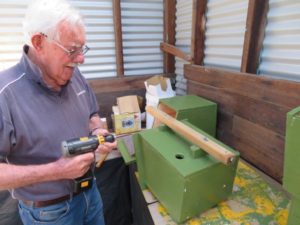
Bruce Smith, Denmark Men’s Shed, making a Phascogale Nesting Box

Green Skills volunteer, Don Hunt, painting a Phascogale Box, Nov 2018
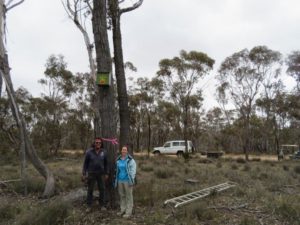
Brian Bilney and Laura Page of Stirling Range Retreat, beneath one of the newly installed Phascogale Nesting Box. Nov 2018
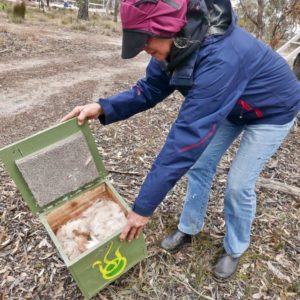
View of inside of Phascogale Nesting box showing Alpaca wool kindly donated by Pentland Alpaca Stud in Denmark.
by Basil | Nov 21, 2018 | Green Skills Inc. - Sustainability Non-Profit
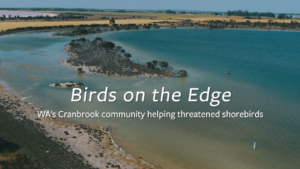
Birds on the Edge
Birds on the Edge:
WA’s Cranbrook Community Helping Threatened Shorebirds
Link: https://www.youtube.com/watch?v=DwO5s3XWM8c
The Salt Lakes around Cranbrook, north of the iconic Stirling Range National Park, are one of WA’s hidden treasures. This 7minute You Tube film shows how the Cranbrook community and landholders are taking action to conserve these lakes, for the benefit of their prolific birdlife.
Farmers, working with community groups The Gillamii Centre and Green Skills, are fencing and rehabilitating the foreshores of their Salt Lakes, helping threatened shorebirds such as the Hooded Plover. The Cranbrook Primary School is also playing its part in helping building greater knowledge and support for these precious wetlands.
Special thanks in helping produce this film goes to Sandy Hope, Tony Peterson, John Chandler, the Lehmann Family, Geraldine and Steve Janicke, Graham Jones, Cameron Williamson, Anne Bondin, Brad Kneebone, Marcus Singor, Graeme Bradshaw, Rhonda Carnegie, Karina Bateman, Wendy Bradshaw, and staff, parents and students of the Cranbrook Primary School.
The Gondwana Wetlands North Stirling Lakes project has been supported by the following organisations: Green Skills, The Gillamii Centre, The Koorabup Trust, Birdlife Australia, Gondwana Link Ltd, Greening Australia, The WA Government’s Natural Resource Management Program, South Coast NRM and the Australia’s Government’s National Landcare Program, Steve and Geraldine Janicke, and the International Living Lakes Network.
This film was created by Earthrise Productions and produced by Green Skills Inc. For further information contact Basil Schur at the Green Skills Denmark office on 08-98483310 or [email protected]
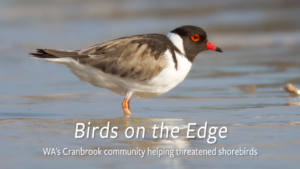
Hooded Plover – Shorebird species at risk
by Basil | Nov 14, 2018 | Green Skills Inc. - Sustainability Non-Profit
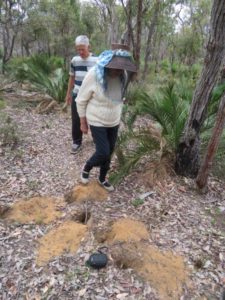
Wolyie Diggings on the trail at Perup – Digging mammals are nature’s engineers..
A visit to Perup – A special place to see threatened native fauna
Between 9 and 11 November I joined in an event organised by GreenTeach, an environmental education group based in Bunbury – for a delightful weekend at Perup- Nature’s Guest House. https\://www.perupnaturesguesthouse.com.au/ Surrounded by the 56,000 hectare Tone-Perup Nature Reserve south of Boyup Brook., Perup: is a great place to see our native fauna.
On behalf of Green Skills I led a dusk walk for a group of about 25 people ranging from 10 to 80 in age. During the two days we were able to spot a range of species including Quenda, possums and the threatened Tammar wallaby.
A highlight of the weekend for me was seeing how Perup Nature’s Guesthouse works as a community enterprise run by the Blackwood Basin Group.
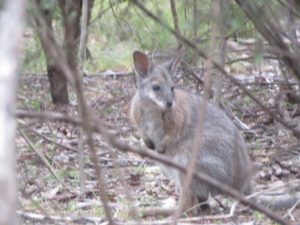
Tammar Wallaby at Perup
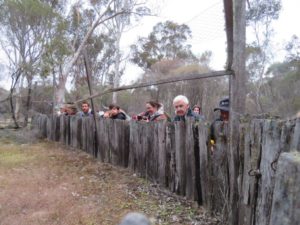
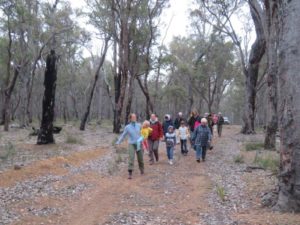
Dusk walk with group from Green Teach, Bunbury
by Basil | Oct 30, 2018 | Green Skills Inc. - Sustainability Non-Profit

Salt Lake Wetland survey outing with Cranbrook Primary School
On Thursday 25th October 2018, Green Skills and Gillamii Centre held a wetland citizen Science day on three special salt lakes near Cranbrook. Geraldine and Steve Janicke, aquatic ecologists, carried out water and invertebrate fauna monitoring of the lakes with the keen interests of a class from Cranbrook School.
Three lakes in the North Stirlings region were visited during the day; Tom South Lake which was recently fenced through State NRM and Federal landcare funding, as part of measures to protect the threatened Hooded Plover species, and Bob’s Lake with its popular bird-hide and prolific aquatic and bird life.
Craig Carter of Earthrise Productions, filmed the days events for the next documentary in the Gondwana Wetland series on the Green Skills YouTube channel. Stay tuned for when that film comes out !
Green Skills’ volunteer Tony Peterson carried out a bird survey, finding many Red necked Avocet and Australian Shelduck using Tom South at the moment. Karina Bateman, of the Gillamii Centre and local farmers Cameron Willamson and Sam Lehmann, also were interviewed during the day.
John Chandler brought out his drone and managed to get some aerial footage of the lakes despite the windy conditions.
The event was supported by the Koorabup Trust, the Lehmann Family, and the Gillamii Centre.
For further info contact Basil at the Green Skills Denmark office on 98483310
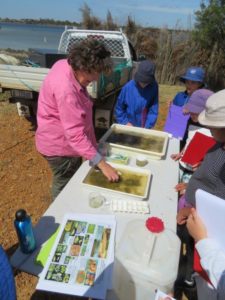
Geraldine Janicke, wetland scientist, with Cranbrook students at Bob’s Lake, Cranbrook
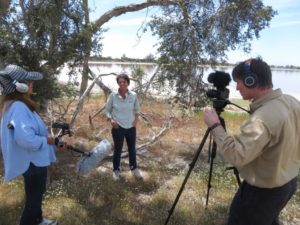
Karina Bateman of Gillamii Centre being interviewed at Tom South Lake
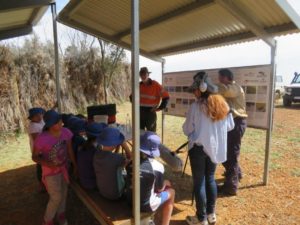
Steve Janicke, weltand scientist, with Cranbrook Students at Bobs Lake Bird Hide
by Basil | Oct 8, 2018 | Green Skills Inc. - Sustainability Non-Profit
Eco-Restoration Report back from SERA Conference Brisbane Sept 2018- Society for Ecological Restoration Australasia 2018 Conference
By Basil Schur, Green Skills
[email protected]
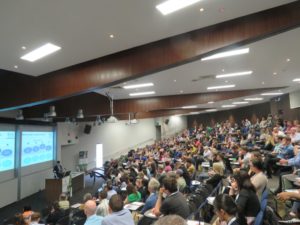
Introduction
Between 25 and 28 September 2018 I attended the Society for Ecological Restoration Australasia conference held at the University of Queensland at St Lucia, Brisbane. Representing Green Skills, I would like to acknowledge the support of Green Skills and South Coast NRM in being able to attend this conference.
I gave two presentations. The first “Using the YouTube platform to promote Gondwana Link eco-restoration” and the second “Using Hooded Plover to promote restoration of lake foreshores in WA’s Great Southern”. Both attracted audiences of about 40 to 50 people and appeared to generate interest and questions.
Overall impressions
The conference brought together over 300 people of diverse background with a strong focus on research and applied aspects of ecological restoration covering both terrestrial, aquatic and marine ecosystems. Although 3 days of listening and discussing followed by a long day of a coastal tour is a lot to handle, I did gain a lot from the diversity of knowledge and experience presented. The conference highlighted for me the economic size of the sector, yet how hard non-government organisations find it to access sufficient resources especially for monitoring and longer term organisational support.
I noted some big gaps in subjects covered; no report backs from how landscape scale or trans-boundary projects are going, no review or concern about inadequate government biodiversity programs, little integration between advocacy/protection/ and restoration programs and relative merits of each, little reporting by utilities (ie water) reporting on their large scale restoration catchment or riparian campaigns, with the eception of mine site rehabilitation, no review of other industry performance with respect to ecological restoration (ie agriculture, forestry). The topic of remote sensing/GIS was poorly represented. There was also no presentations by some of the big players in private land management ( Land for Wildlife programs, Bush Heritage, Australian Wildlife Conservancy).
While I found the conference great for providing a professional development opportunity, I would have preferred part of the conference to have allowed for more networking and small group session, ideally with open technology format. It would also have helped to make the overall conference more inspirational if it included more music, art and cultural activities.
Some take home lessons I learnt:
- How advanced is the research program associated with the native seed industry and the importance of direct seeding approaches keeping up to date with these advances.
- Need to incorporate the National Ecological Restoration Standards into project framing and design- I recognised how inadequately I have referenced these standards in my own projects.
- Availability of platforms for promoting eco-restoration through films ( ie Regen TV see https://www.aabr.org.au/regentv/ )
- The value of social network theory in helping improve public engagement and project promotion.
- How big the Bush regeneration industry has become in Eastern Australia and how much support given at Local Council level.
- A wide range of eco-restoration approaches now include a sophisticated incorporation of climate change understandings.
- The thought going into scaling up eco-restoration, and how difficult this is with coral reef and sea grass restoration.
Some Opportunities
- Value of linking University research programs of community eco-restoration priorities.
- Social enterprises linked to eco restoration
- Highlighting Eastern state examples of Local Government Support for long term bush regeneration and management
- Economic case study linked to Gondwana Link ( I invited Dr Makysym Polyakov of UWA to have his team focus a project on Gondwana link – perhaps a Cost Benefit analysis
Presentations attended:
I attended a wide range of key note and shorter presentations. A booklet of all the summaries and most of the key note power-point points will be available on the SERA conference website.
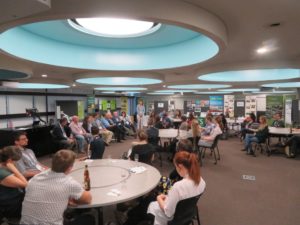
Keynote Talks
- Professor Jakki Mohr USA “Challenges in innovation in ecological restoration”
- Professor David Lindenmayer “Key lessons form long term research for restoration and integrating conservation and agricultural production .”
- Dr Makysym Polyakov “Thinking differently about restoration: economist’s perspective.”
- Dr Tein McDonald “How the National Restoration Standard’s affirmation of native ecosystems as references can strengthen SERA’s function as a broad church”
- Associate Professors Daniel Laughlin: “Are historical reference conditions an ecological fairy tale or are they more relevant than ever?”
- Professor Kerrie Wilson “ Better decision making in ecological restoration “
- Dr Linda Broadhurst“ How genetics can influence long term restoration outcomes”.
- Dr Paul Gibson Roy: “ Native Seed production- farming for restoration supply: Lessons from local and US sectors”
A major stream at the conference dealt with rainforest restoration in the Big Scrub area of Northern NSW.
Ecological Restoration Practice in the Big Scrub, North Eastern NSW
- Mike Delaney “Saving the Big Scrub”
- Tein McDonald “Recovery processes underpinning rainforest restoration in the Big Scrub”

Social Dimensions of Restoration
- Tom Atkinson Rehabilitating Roe 8; a standard approach to a not so standard restoration project
- Samantha Colbrum ( Gold Coast) When the Funding finishes; continuing conservation efforts through community connections
- Todd Dudley Tasmania “ How ecological restoration can facilitate a nature conservation culture.”
Aquatic Systems Restoration
- Jasper Nielsen ” Reverting the Brisbane River Estuary from brown to blue.”
- Lance Lloyd “The Makoon Project: The Ecological renewal of an ephemeral wetland system in North East Victortia ( Winton Wetlands}”
- Emerging Eco Engineering Solutions and Seed Enhancement Technologies to Combat Land Degradation by Todd Erikson, Shane Turner, Alison Ritchie et al.
Expanding the Restoration Toolkit
- Maurizio Rassetto ( NSW) “Restore and Renew: Large scale evolutionary, environmental and ecological information in support of restoration practices”
- Luke Shoo (Gold Coast) “Smart allocation of restoration funds”
From Small to Large Scale – Marine Coastal Restoration
- Elisa Boryroktarov “Marine Coastal Restoration of the last 45 years.”
- Sarah Fias-Torres ( Seattle, USA) “How to restore a coral reef: When bigger is better.”
- Simon Reeves (Nature Conservancy, Australia) “The case for marine restoration projects”
- John Statton ( WA) “Social and Ecological challenges and new directions in seagrass restoration.”
- Catherine Lovelock ( Qld) “Restoration of coastal ecosystem and Blue Carbon.”
Seagrass Restoration Network: A new Community of Research and Practice.
- Elizabeth Sinclair “ Tackling a global problem- developing seagrass restoration methods for boat mooring scars”
- Lana Kajich “ Spreading the seeds of Change: Optimising community engagement efforts to improve seagrass restoration”
Scaling Up Restoration
Scaling Up Session : Papers read;
- Glen Steven “ Large scale restoration at small scale costs in Southwest Western Australia”
- Barry Heydenrych “Applying the SERA Standards to large-scale restoration in Gondwana Link (South-Western Australia) – challenges and approaches
Photos
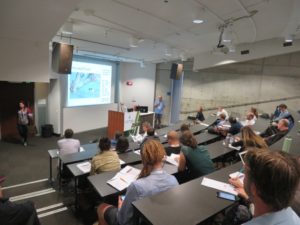
Myself presenting at the conference ( On Hooded Plover/Lake foreshore Conservation)
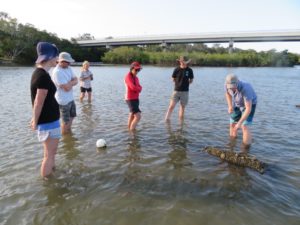
I attended the Marine and Coastal tour for the Conference. Here we are looking a trail Oyste Shell fish habitat restoration project site on the Noosa River, Sunshine Coast.
 Inspecting a small mangrove rehabilitation project run by a community group in Coolangatta, on the Sunshine Coast.
Inspecting a small mangrove rehabilitation project run by a community group in Coolangatta, on the Sunshine Coast.
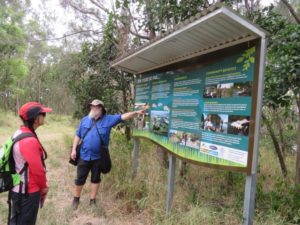 At the Bullimba Creek restoration site interpretative signage, a major 25 year old and ongoing, award winning, eco-engineering restoration site at Brisbane Port.
At the Bullimba Creek restoration site interpretative signage, a major 25 year old and ongoing, award winning, eco-engineering restoration site at Brisbane Port.
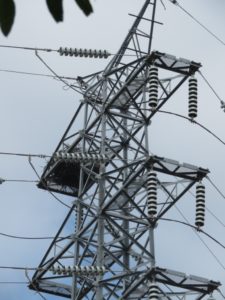 A Sea Eagle’s nest in a pylon at the Bullimba Creek restoration site, Brisbane Port.
A Sea Eagle’s nest in a pylon at the Bullimba Creek restoration site, Brisbane Port.





















 Inspecting a small mangrove rehabilitation project run by a community group in Coolangatta, on the Sunshine Coast.
Inspecting a small mangrove rehabilitation project run by a community group in Coolangatta, on the Sunshine Coast. At the Bullimba Creek restoration site interpretative signage, a major 25 year old and ongoing, award winning, eco-engineering restoration site at Brisbane Port.
At the Bullimba Creek restoration site interpretative signage, a major 25 year old and ongoing, award winning, eco-engineering restoration site at Brisbane Port. A Sea Eagle’s nest in a pylon at the Bullimba Creek restoration site, Brisbane Port.
A Sea Eagle’s nest in a pylon at the Bullimba Creek restoration site, Brisbane Port.